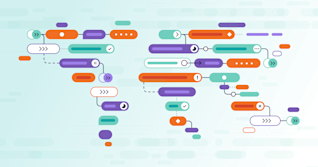Product designers often choose to become a designer because of the hard-to-beat and attractive promise that accompanies it: improving the lives of people by adding value through design. Being a designer, I can vouch for how fulfilling and rewarding it can be to see a bud of an idea grow into a feature that is enjoyed by users. However, the demands of product designers can quickly become overwhelming as roles, products, and teams evolve - if left unchecked, this can result in burnout. In this blog, I will discuss how to avoid burnout by being intentional about time management and communication.
What is a product designer’s scope?
At GitLab, similar to many other software companies, product designer responsibilities span designing thoughtfully crafted experiences, playing a central role in the overall business contributions, and everyday collaboration with key product stakeholders. The spectrum has grown over time, leading to a general misconception among designers that they are required to overreach their potential to prove their pedigree. Instead, taking up the right responsibility at the right time and doing it well often produces better results.
Define your own frame
Each product designer envisions growth differently. In the pursuit of growth, to demonstrate specific expertise or leadership qualities, each designer may have a unique goal in mind in terms of the means you want to employ or the results you seek from that goal. Also, this implies that you cannot trust a generic template approach to map your priorities. The lens you use to distinguish important responsibilities and tasks from the rest are unique and your planning and rituals should be as well.
Establish an availability baseline
A couple years ago, my manager, Rayana Verissimo, gave me a task of writing down an approximate estimation of how much time I plan to dedicate to each of the major responsibilities in my role. The math seemed simple at first: I work 40 hours a week and I had a list of about eight responsibilities. I had an idea in mind on how to divide up those responsibilities. What could go wrong?
As they say, life happens while we’re busy making other plans. I was preparing to move between countries and, in that same timeframe, our team was onboarding a new product manager. Without realizing it, I began spending a considerable amount of time at work on admin-related tasks and getting my processes in sync with my new product manager. These shifts were unannounced and unavoidable. Such surprise challenges are a part of all of our lives, though the form may vary. But when they happen, it is best to be accepting of them and keep some wiggle room in your time allotment estimation to accommodate them without disturbing the rest of your plan.
There are different ways to understand and manage your capacity. Sunjung Park, a product designer at GitLab, relies on the UX issue weights framework to maintain a closer to accurate predictability of her tasks for a release cycle. I personally like to use the same and communicate my capacity for the release cycle to the team using a planning issue.
Assess the importance of a task to you
Despite the evident benefits, McKinsey Design Index proved to be the very sign that the tech and other industries had always been looking for to validate the correlation between design and financial performance of an organization. Realizing how it can help them differentiate in the industry and directly impact revenue streams, organizations now expect designers to make some business-critical decisions, thereby expanding their responsibilities to be more cross-functional.
This evolution has led product designers to jump at every opportunity and request. However, if you do not take a moment to assess the “why” of the opportunity or request, you’re merely setting yourself up for failure. Product designers can ask some questions to help decide whether to take on the project:
- Does the project require my expertise and skills, or help me develop one that aligns with my personal goals?
- Does the project contribute to the business' goals?
- Is this project something that someone else can do better than I can - while I invest my time doing something that I can do more confidently?
- Am I on the same page with the requestor in terms of expectations and time commitment?
- Will my delivery plan get impacted if I commit to this project? If so, what trade-offs can or need to be made?
Build trust and communicate transparently
The urge to say “yes” is an instinct of human behavior. However, when you say yes to every request from our peers/colleagues, you feed the cycle of responsiveness to become more intense, to a point where you no longer can respond to the demand. This overwhelming wave of expectations puts you in a position where you stop exercising your creative muscles out of exhaustion and merely keep working more and more, driving down the quality of results. Making it a false victory, if one at all. Ironically, this, in turn, impacts the very relationship that you said “yes” to in the first place.
I have already talked about how to decide if an opportunity or request is aligned to your goals. If the answer to that is “it isn’t,” the next thing you need to do is communicate that clearly to the requester.
A plain “no” can easily be perceived as rude, but kindly communicating an honest and straightforward reason will have a higher chance of building trust with your peers than saying yes and delivering substandard results. The GitLab sub-value Directness emphasizes the importance of transparent communication with colleagues. Another method a few members of my team, including me, use for maintaining transparency in everyday priorities is documenting them publicly in a GitLab project and keeping them visible to the team and our counterparts.
A checklist to avoid burnout
If you're looking to continue to enjoy your work as a product designer while also growing in your job, the following tips can help:
- Take a step back and try to understand your own drives and motivations so you can more effectively plan your path ahead.
- Be realistic about your capacity and potential trade-offs, and communicate the same to your team transparently.
- Be discerning while taking up a new opportunity, ensure it aligns with your goals, and be comfortable passing it along to a colleague that is better suited if it doesn't.
- Keep your communication honest, humble, and non-ambiguous to avoid miscalculated commitments that can harm relationships with your peers.
Mindfully and intentionally assessing a new opportunity rather than reacting by impulse can play a major role in setting yourself, and your colleagues, up for success, resulting in a happier, more impactful, and less stressful work environment.
Cover image by freestocks on Unsplash



